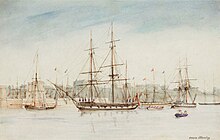William Snow Harris | |
|---|---|
| Born | 1 April 1791 Plymouth, Devon, England |
| Died | 22 January 1867 (aged 75) |
| Occupation(s) | solicitor and physician |
Sir William Snow Harris (1 April 1791 – 22 January 1867) was a British physician and electrical researcher,[1] nicknamed Thunder-and-Lightning Harris,[2] and noted for his invention of a successful system of lightning conductors for ships. It took many years of campaigning, research and successful testing before the British Royal Navy changed to Harris's conductors from their previous less effective system. One of the successful test vessels was HMS Beagle which survived lightning strikes unharmed on her famous voyage with Charles Darwin.[3][4]

- ^ Cite error: The named reference
ebwas invoked but never defined (see the help page). - ^ Barlow 1967, p. 49
- ^ Uman, Martin A. (2008). The Art and Science of Lightning Protection. Cambridge University Press. pp. 175–176, 179. ISBN 978-0-521-87811-1.
- ^ Bernstein, Theodore & Reynolds, Terry S (1978). "Protecting the Royal Navy from Lightning, William Snow Harris and His Struggle with the British Admiralty for Fixed Lightning Conductors". IEEE Transactions on Education. 21 (1): 7–14. doi:10.1109/TE.1978.4321177. S2CID 46380992.